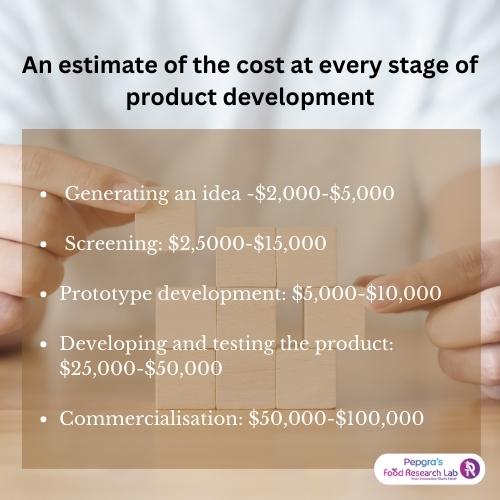
What is the Cost of Developing a New Product?
Introduction
New product development (NPD) involves the transformation of an opportunity in the market into a commercial product, which is achieved by a well-defined procedure. Developing a new food product can be risky since it depends on numerous factors like company strategy, competitors, processes and consumer preferences, but it can lead to market growth. As a result, it can set a competitive advantage for the company. Therefore, the food manufacturers must have an estimate of the cost of developing a new product to avoid financial risks and gain the trust of the lending agent.
Factors affecting the cost of developing a new product
Ingredient selection, sourcing and the technology for developing a product affect the cost of developing a new product.
- Ingredients: Ingredients sourced locally are perceived to be of better quality and are relatively economical.
- Sourcing and distribution of the ingredients: Ingredients tend to cost more reasonably if they are sourced and procured locally since no extensive transportation is needed.
- Technology: Advancements in developing a new product using the latest technology, testing and ingredient traceability significantly improve food product quality. More sophisticated technology implies a higher cost for developing a new product [1].
Cost of developing a new food product
Developing a new food product can be exciting, and the cost for that purpose can be estimated at every step, which is as follows:

- Researching an idea: Many techniques are implemented by companies to generate an idea for developing a new product, such as an idea from a competitor, market & consumer research, attending a trade show or searching for publications. An idea can also be generated in a corporation by a discussion involving members from all the departments. The idea generation process may cost roughly between $2,000 to $5,000.
- Screening: Screening is a critical step in product development which involves participants for assessing the various product development factors, such as financial and legal considerations, process and equipment accessibility, purchasing power and ingredient accessibility, market shifts, and consumer perceptions. To properly screen products, markets must be examined. Screening gives information that will be helpful in upcoming market plans. The screening process may cost between $2,500 to $15,000 [2].
- Prototype development: A prototype is often developed before the actual product. The prototype gives a rough estimate of the final product, which can help determine the product’s feasibility and reduces risks in the long run. Prototyping may cost between $5,000 to $10,000 per iteration [2,3].
- Developing and testing the product: The Food firms must produce the product in small batches, called pilot manufacturing to determine if the product is acceptable and what improvements could be made and must focus on packaging and labelling. Consumer tests are also undertaken to evaluate product acceptability. Questionnaires will help determine the areas of improvement of the product, and hence a typical methodology for food product testing has to be followed. Product certification is also done in this process. This stage may cost between $25,000 to $50,000.
- Commercialisation: Once the product is successful in the market tests, it can be commercialised. At this stage, a location must be finalized to set up the manufacturing plant, equipment and workforce. The final step, called product maintenance should prioritise enhancing quality and increasing profits. Quality factors are maintained by tracking the product’s potential flaws as it is handled during processing, distribution, and display. Product promotion is done at this stage with the help of advertisements and coupons. This step may cost between $50,000 to $100,000 [2].
Conclusion
Food product development is a complex process, and the cost depends on factors like ingredients, sourcing and procurement and technology. Idea generation, screening, prototype development, product development and testing and commercialization are the steps for developing a food product. One can roughly estimate the cost of developing a food product, ranging from $85,000 to $175,000. Proper planning and implementation can make the food development process more economical.
How the Food Research Lab can help
The Food Research Lab offers B2B service in product development. It assists its clients in developing a new product, mimicking an existing product or adding a new variant, like a new flavored product. It also offers pilot manufacturing, which produces the product in small batches, which helps improve the product quality significantly, ensuring the final product is successful. In addition, it performs cost analysis for its clients to develop a product that is of a high-quality while being economical.





